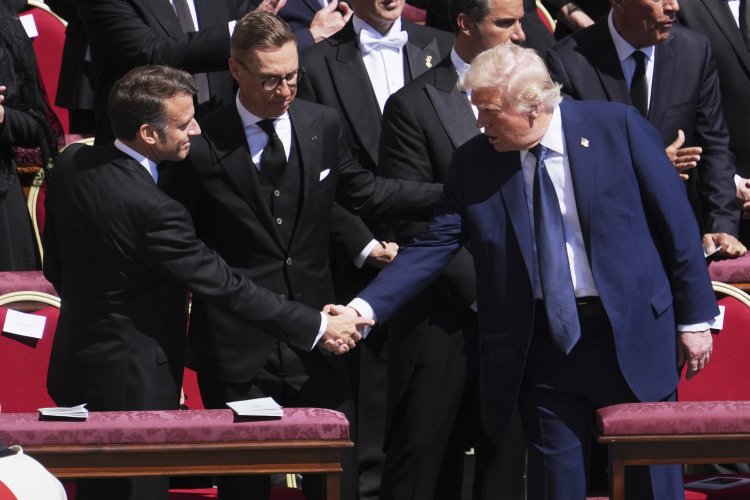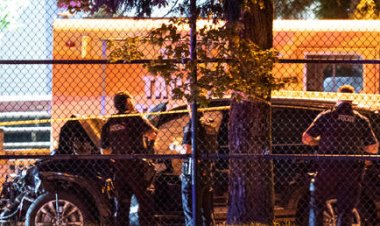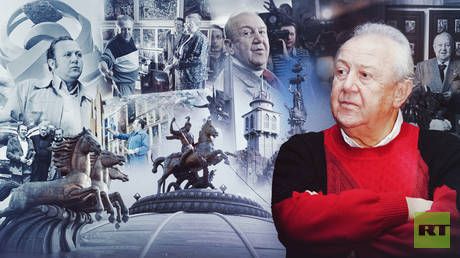Trump emerges from seclusion to greet global leaders in Vatican City
Trump is the second sitting U.S. president to participate in a papal funeral, a notable event occurring amid the backdrop of the U.S.'s growing isolationist stance.

The necessity of the U.S., and by extension Trump, was highlighted by the meeting that occurred between Trump and Ukrainian President Volodymyr Zelenskyy inside St. Peter’s Basilica during the event. French President Emmanuel Macron and United Kingdom Prime Minister Keir Starmer also engaged in discussions with the two leaders.
Conversely, Trump seeks their attention and goodwill. He effortlessly engaged with various dignitaries, who flocked to him upon his arrival, sitting front row. This contrasted with former President Joe Biden, who was seated several rows back and interacted with the crowd before the ceremony, taking selfies and chatting with other leaders.
While most foreign officials wore traditional black suits, Trump opted for a navy blue suit and matching tie, adding a subtle splash of color to the solemn occasion.
European Commission President Ursula von der Leyen, who had been vocal in her desire to meet Trump during the service, quickly sought a moment with him. Throughout the ceremony, Trump and First Lady Melania Trump conversed with Estonian President Alar Karis, while Finnish President Alexander Stubb offered the president water as the sun blazed overhead.
The only scripture read in English during the service subtly critiqued the “America First” principle, affirming that faith transcends national borders. “Truly, I understand that God shows no partiality, but in every nation, anyone who fears him and does what is right is acceptable to him,” stated Kielce Gussie, an American journalist from Vatican News, quoting the apostle Peter from the book of Acts.
This message reflected the unity that Francis has often emphasized, including in his final Easter Sunday address, where he declared, “All of us are children of God.” Such sentiments challenge Trump’s hardline stance on immigration, which he has maintained since his 2015 presidential campaign, alongside his increasingly isolationist approach during this term, marked by hefty tariffs on allies and adversaries alike, as well as cuts to millions in foreign aid for various humanitarian causes.
The global perspective was also illustrated by the attendance of over 250,000 mourners and at least 130 foreign delegations at Saturday’s funeral. Thousands more visited St. Peter's Basilica over the preceding days to pay their respects to Francis as he lay in state.
Trump’s preoccupation with the U.S.-Mexico border wall has starkly highlighted the divide between the U.S. and the rest of the world. Just prior to the funeral, he asserted to reporters on Air Force One that the border situation had been “solved,” offering no further details. In contrast, Francis had insisted in 2016 that anyone “who only thinks about building walls... and not building bridges, is not Christian.”
Despite this, Trump has enjoyed strong backing from Catholics, a community wrestling with internal divisions between the progressive ideals of Francis and the traditionalism represented by Trump’s Vice President, JD Vance. This dichotomy was evident earlier this year when Francis challenged Vance’s narrow definition of ordo amoris, emphasizing that compassion should extend beyond immediate family and community.
“Christian love is not a concentric expansion of interests that little by little extend to other persons and groups,” the pope asserted.
Trump's attendance at Francis’ funeral was significant, as he became only the second sitting U.S. president, following George W. Bush, to attend a papal funeral. Initially, Trump had intended to visit the Middle East on his first foreign trip. A papal funeral presents a unique challenge for someone not particularly identified with faith and who had alienated many notable figures in attendance over the last 100 days.
Often portrayed as Trump’s foil, Francis lived a life of humility and service, advocating for the marginalized. Following the service, a procession carried Francis’ casket to Santa Maria Maggiore Basilica, where he was laid to rest in a modest gathering of 40 people, including prisoners, the homeless, migrants, sex workers, and transgender individuals—far removed from the opulence typically surrounding papal funerals in the Vatican.
Trump's decision to attend the funeral appeared largely driven by the support he received from Catholics in the 2024 election. In November, Trump garnered 59 percent of the Catholic vote, a notable increase from the 50 percent he secured in 2016 and a marked change, considering Biden’s 52 percent share in 2020, largely attributed to Trump's increased appeal among Latino voters.
On Air Force One prior to the funeral, Trump noted that he was attending “out of respect” but quickly redirected the conversation to himself: “You know, I won the Catholic vote. I don’t know why we didn’t get more, honestly. But we did well with the Catholic vote, and our relationship is very good so therefore I think it’s appropriate.”
Trump has also appointed numerous Catholics to prominent positions within his administration, including Vance. Vance likely had the last significant meeting with Francis—on Easter Sunday—before his death at age 88 due to a stroke and subsequent heart failure. The vice president described his encounter with Francis as “a great blessing,” acknowledging the presence of policy disagreements while also noting common ground.
At a previous meeting in 2017 with Trump and the First Lady at the Vatican, Francis demonstrated how easily barriers can be dismantled, even rhetorical ones, when he cheekily asked Melania if she fed Trump potica, a traditional Slovenian baked roll from her homeland, eliciting smiles from both.
Sanya Singh for TROIB News












